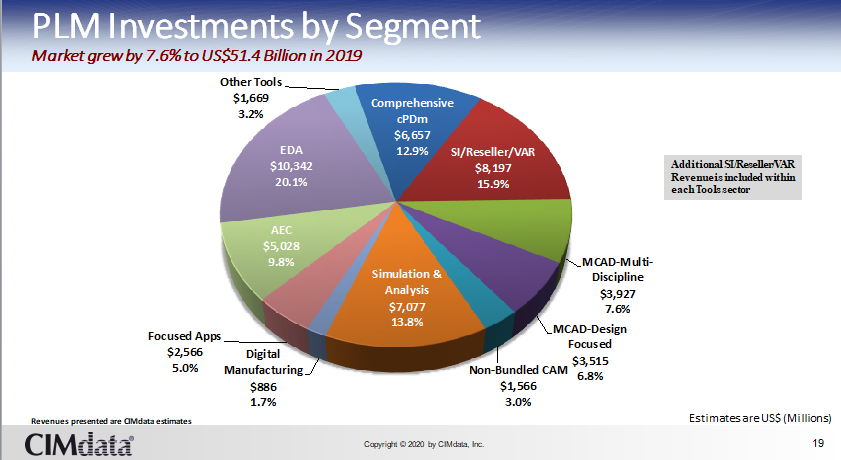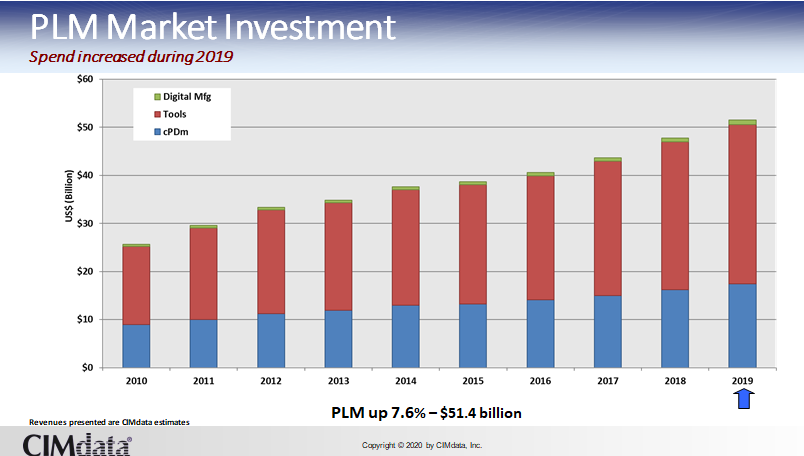2019 Global PLM Market Up 7.6%, COVID-19 Impact Will Be Far Reaching
Overall PLM market in 2019 was up 7.6% to US$51.4 billion, a little under the forecast of 8.6%. Due to the COVID-19 outbreak, the global PLM market is expected to grow by 2.4% in 2020.
On April 10, Peter Bilello, CIMdata President and CEO, Stan Przybylinski, CIMdata Vice President and Dr. Pei Huang, e-works CEO joined in a webinar focusing on the global PLM market 2019. Together they released CIMdata’s 2019 global PLM market analysis results—including extensive analyses and forecasts regarding market growth across PLM domains, industries and regions, and the performance (by revenue and market-share) of leading PLM solution providers and looked towards the future of PLM market affected by the COVID-19 outbreak.
Overall, all segments continued to grow, with only the multidisciplinary MCAD (MCAD-MD) segment struggled.
PLM investment trends from industry perspective
Recent CIMdata research suggests that smart connected products are increasingly important to the success of industrial companies in a range of industries. 96% say smart connected products will be important or very important to their market success. Therefore, the development & management of smart, connected products is changing what PLM is and how it is enabled. In the process, the more specific application of AI, graph databases, and other emerging technologies appear to hold great promise.
According to historical statistics, most of global PLM investments were from automotive, then aerospace and defense, high-tech, and industrial machinery. According to the survey of nearly 200 manufacturing enterprises in the above industries, 65% of the respondents have more than one PLM solution. This is closely related to PLM market mergers and acquisitions, where many large companies built through mergers and acquisitions have many solutions in place. Currently, the business process scope of PLM solution is still heavily weighted towards the “traditional” PDM aspects of PLM, including Document Mgt., Lifecycle Management, Enhanced CAD Mgt., DMU & Compliance. Survey on current annual PLM budget shows that nearly 58% spending more than US$1 million each year. Overall, there’s a positive sign that companies find PLM worth spending money on with 84% saying they will maintain or increase their PLM budget in 2020.
According to the survey on enterprise management, ONLY 14% see PLM as it should be seen, down from 16% in 2019. This is related to process and functions overlap and lack of ROI clarity. According to the survey, 56% of respondents still consider the term “PLM” a buzzword. Peter Bilello, President of CIMdata, said “PLM is still critical for businesses. It’s not just technologies or any IT system, but a strategic business approach to support research and development”.
PLM market in 2019 still active
CIMdata and e-works tracked 106 mergers and acquisitions in the past year through a global survey of approximately 700 companies. It was a little below the 135 acquisitions in 2017 and 123 in 2018, but was more than 95 in 2015 and 74 in 2016.
Notable acquisitions include: Dassault Systèmes adds elecworks (ECAD) and Medidata; Autodesk acquired BuildingConnected, digital construction network now at core of the Autodesk Construction Cloud; PTC acquired Onshape; SAP acquired Qualtrics (XM); Siemens Digital Industries Software (4) adds Saab Medav Technologies GmbH (NVH), Atlas 3D (DMLS), MultiMechanics (FEM), ESTEQ (Safr VAR); Altair with SEAM (high-freq NV) and DEM Solutions (bulk matl); Ansys (5) with Helic (emag), Granta Design, DfR Solutions (reliability), LSTC (LS-Dyna), Dynardo (PIDO).
Besides, Cadence acquired AWR Corporation (hi-freq RF); Synopsys added Qtronic GmbH (auto sim/test), eSilicon IP, DINI (FPGA boards); Zuken bought Vitech Corporation (MBSE); Accenture still very active (15), emphasis on IoT, analytics/AI (Analytics8, Clarity Insights, Knowledgent, Pragsis Bidoop), regional focused SIs, bolstering Industry X.0 (Enterprise System Partners, Zielpuls); Hexagon (5) with Etalon (mfg quality data), AMendate (AM sim), Melown Technologies (landscape viz), Volume Graphics (ind CT), Thermopylae (geosp); Rockwell Automation adds Emulate3D (Ind auto sim); Schneider Electric adds AutoGrid (AI/ML).
From the perspective of vendor distribution, most PLM market is led by industry leaders, including Dassault Systemes, Oracle, PTC, SAP, Siemens Digital Industries Software, etc. Aras is pushing its way into the group. Other major providers include Autodesk, IBM, IFS, Infor and NEC, as well as the local providers in regional markets such as China and Russia.
It’s worth mentioning that Autodesk and PTC had largely completed their license model transition. However it’s still a question that whether others will follow.
In addition, SI/Reseller/VAR are the most active segment, led by Accenture again. In overall cPDm market, services revenue are 58.8%, driven by independent services providers. In contrast, Comprehensive cPDm providers’ software was 67.4% vs. 32.6% for Services in 2019.
In general, The PLM market continues to expand and evolve and differentiation is key.
COVID-19’s impact will be far reaching
According to CIMdata, COVID-19 will have huge impacts over the next 12-18 months. PLM during the Great Recession, the last major disruption, offers a model.
From the perspective of Economic impact, large-scale quarantines, travel restrictions, and social distancing measures drive a sharp fall in consumer and business spending until the end of 02, producing a recession. Although the outbreak comes under control in most parts of the world by late in Q2, the self-reinforcing dynamics of a recession kick in and prolong the slump until the end of Q3. Demand suffers as consumers cut spending throughout the year. In the most affected sectors, the number of corporate layoffs and bankruptcies rises throughout 2020, feeding a self-reinforcing downward spiral.
Some of these effects will be passed on to the PLM market. But CIMdata forecasts the global PLM market growth of 2.4% in 2020. By comparison, the global PLM market recorded negative growth of 9.6% in 2009 due to the impact of the financial crisis. This means that while PLM investments are suffering from the epidemic, CIMdata estimates that PLM market will keep growing in 2020.
In addition to the impact on market trends, the COVID-19 outbreak will also have a profound impact on PLM technology changes. For example, move to subscription provides some help to stop the bleeding; the cloud helps people work anywhere, anytime, can be an upside as the model takes hold in PLM; How face-to-face consulting services might have to change is a big question facing the industry.

Overall, all segments continued to grow, with only the multidisciplinary MCAD (MCAD-MD) segment struggled.

PLM investment trends from industry perspective
Recent CIMdata research suggests that smart connected products are increasingly important to the success of industrial companies in a range of industries. 96% say smart connected products will be important or very important to their market success. Therefore, the development & management of smart, connected products is changing what PLM is and how it is enabled. In the process, the more specific application of AI, graph databases, and other emerging technologies appear to hold great promise.
According to historical statistics, most of global PLM investments were from automotive, then aerospace and defense, high-tech, and industrial machinery. According to the survey of nearly 200 manufacturing enterprises in the above industries, 65% of the respondents have more than one PLM solution. This is closely related to PLM market mergers and acquisitions, where many large companies built through mergers and acquisitions have many solutions in place. Currently, the business process scope of PLM solution is still heavily weighted towards the “traditional” PDM aspects of PLM, including Document Mgt., Lifecycle Management, Enhanced CAD Mgt., DMU & Compliance. Survey on current annual PLM budget shows that nearly 58% spending more than US$1 million each year. Overall, there’s a positive sign that companies find PLM worth spending money on with 84% saying they will maintain or increase their PLM budget in 2020.
According to the survey on enterprise management, ONLY 14% see PLM as it should be seen, down from 16% in 2019. This is related to process and functions overlap and lack of ROI clarity. According to the survey, 56% of respondents still consider the term “PLM” a buzzword. Peter Bilello, President of CIMdata, said “PLM is still critical for businesses. It’s not just technologies or any IT system, but a strategic business approach to support research and development”.

PLM market in 2019 still active
CIMdata and e-works tracked 106 mergers and acquisitions in the past year through a global survey of approximately 700 companies. It was a little below the 135 acquisitions in 2017 and 123 in 2018, but was more than 95 in 2015 and 74 in 2016.
Notable acquisitions include: Dassault Systèmes adds elecworks (ECAD) and Medidata; Autodesk acquired BuildingConnected, digital construction network now at core of the Autodesk Construction Cloud; PTC acquired Onshape; SAP acquired Qualtrics (XM); Siemens Digital Industries Software (4) adds Saab Medav Technologies GmbH (NVH), Atlas 3D (DMLS), MultiMechanics (FEM), ESTEQ (Safr VAR); Altair with SEAM (high-freq NV) and DEM Solutions (bulk matl); Ansys (5) with Helic (emag), Granta Design, DfR Solutions (reliability), LSTC (LS-Dyna), Dynardo (PIDO).
Besides, Cadence acquired AWR Corporation (hi-freq RF); Synopsys added Qtronic GmbH (auto sim/test), eSilicon IP, DINI (FPGA boards); Zuken bought Vitech Corporation (MBSE); Accenture still very active (15), emphasis on IoT, analytics/AI (Analytics8, Clarity Insights, Knowledgent, Pragsis Bidoop), regional focused SIs, bolstering Industry X.0 (Enterprise System Partners, Zielpuls); Hexagon (5) with Etalon (mfg quality data), AMendate (AM sim), Melown Technologies (landscape viz), Volume Graphics (ind CT), Thermopylae (geosp); Rockwell Automation adds Emulate3D (Ind auto sim); Schneider Electric adds AutoGrid (AI/ML).
From the perspective of vendor distribution, most PLM market is led by industry leaders, including Dassault Systemes, Oracle, PTC, SAP, Siemens Digital Industries Software, etc. Aras is pushing its way into the group. Other major providers include Autodesk, IBM, IFS, Infor and NEC, as well as the local providers in regional markets such as China and Russia.
It’s worth mentioning that Autodesk and PTC had largely completed their license model transition. However it’s still a question that whether others will follow.
In addition, SI/Reseller/VAR are the most active segment, led by Accenture again. In overall cPDm market, services revenue are 58.8%, driven by independent services providers. In contrast, Comprehensive cPDm providers’ software was 67.4% vs. 32.6% for Services in 2019.
In general, The PLM market continues to expand and evolve and differentiation is key.
COVID-19’s impact will be far reaching
According to CIMdata, COVID-19 will have huge impacts over the next 12-18 months. PLM during the Great Recession, the last major disruption, offers a model.
From the perspective of Economic impact, large-scale quarantines, travel restrictions, and social distancing measures drive a sharp fall in consumer and business spending until the end of 02, producing a recession. Although the outbreak comes under control in most parts of the world by late in Q2, the self-reinforcing dynamics of a recession kick in and prolong the slump until the end of Q3. Demand suffers as consumers cut spending throughout the year. In the most affected sectors, the number of corporate layoffs and bankruptcies rises throughout 2020, feeding a self-reinforcing downward spiral.
Some of these effects will be passed on to the PLM market. But CIMdata forecasts the global PLM market growth of 2.4% in 2020. By comparison, the global PLM market recorded negative growth of 9.6% in 2009 due to the impact of the financial crisis. This means that while PLM investments are suffering from the epidemic, CIMdata estimates that PLM market will keep growing in 2020.
In addition to the impact on market trends, the COVID-19 outbreak will also have a profound impact on PLM technology changes. For example, move to subscription provides some help to stop the bleeding; the cloud helps people work anywhere, anytime, can be an upside as the model takes hold in PLM; How face-to-face consulting services might have to change is a big question facing the industry.








